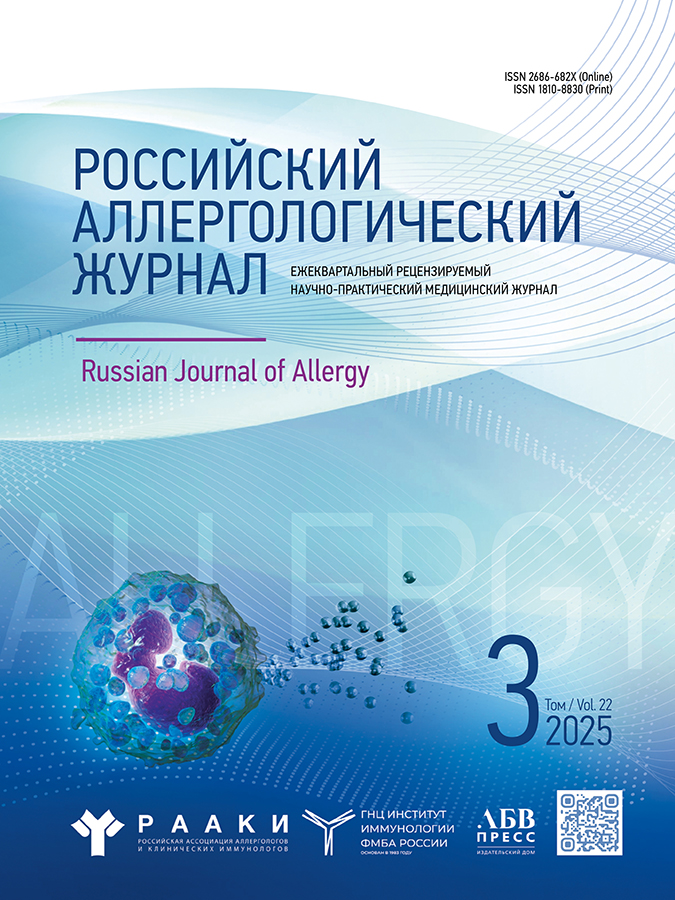FOOD ANAPHYLAXIS IN CHILDREN: RETROSPECTIVE ANALYSIS OF 53 CASES
- Authors: Esakova NV1, Pampura AN1
-
Affiliations:
- Moscow research Institute of pediatric and child Surgery
- Issue: Vol 10, No 5 (2013)
- Pages: 22-26
- Section: Articles
- Submitted: 10.03.2020
- Published: 15.12.2013
- URL: https://rusalljournal.ru/raj/article/view/607
- DOI: https://doi.org/10.36691/RJA607
- ID: 607
Cite item
Abstract
Introduction. There are no studies on anaphylaxis in children in Russian Federation therefore this problem is a topical issue. Background. To determine the etiology, natural course of food anaphylaxis in Russian Federation children, to analyse the therapeutic care of anaphylaxis. Methods. 53 patients with food anaphylaxis were included in the study. All patients completed a questionnaire included questions about the triggers, clinical manifestations and treatment of anaphylaxis. Results. In 94% episodes of anaphylactic reactions occurred at home, 2/3 (66%) of patients had two or more episodes of food anaphylaxis before, 5 (8%) infants didn’t have allergic diseases, 23 patients (43%) had anaphylactic reactions to more than one product. Cow’s milk (43%) was the most common cause of anaphylaxis. Cow’s milk caused anaphylaxis in 67% of children under 2 years (p<0,0001). In 98% of patients target organs of anaphylactic reacnions were skin / mucous and in 87% — respiratory system. In the group of children over 2 years old cardiovascular symptoms were more often (p<0,00l5). In the majority of patients delayed diagnosis of anaphylaxis more than 4 years was estimaited. Only 7% of children had the injection of adrenaline during anaphylactic reactions. Conclusion. The results of the study showed the lack of experience in investigation of anaphylaxis in the Russian Federation, which consequently leads to incorrect diagnosis and not effective treatment.
Keywords
Full Text
About the authors
N V Esakova
Moscow research Institute of pediatric and child Surgery
Email: env007@rambler.ru
Russia
A N Pampura
Moscow research Institute of pediatric and child SurgeryRussia
References
- Cianferoni A., Novembre E., Mugnaini L. et al. Clinical features of acute anaphylaxis in patients admitted to a university hospital: an 11-year retrospective review (1985—1996). Ann. Allergy Asthma Immunol. 2001, v. 87 (1), p. 27-32.
- Wang J., Sampson H.A. Food anaphylaxis. Clin. Exp. Allergy. 2007, v. 37 (5), p. 651-660.
- Neugut A.I., Ghatak A.T., Miller R.L. Anaphylaxis in the United States: an investigation into its epidemiology. Arch. Intern. Med. 2001, v. 161 (1), p. 15-21.
- Decker W.W., Campbell R.L., Manivannan V. et al. The etiology and incidence of anaphylaxis in Rochester, Minnesota: a report from the Rochester Epidemiology Project. J. Allergy Clin. Immunol. 2008, v. 122 (6), p. 1161-1165.
- Bohlke K., Davis R.L., DeStefano F. et al. Epidemiology of anaphylaxis among children and adolescents enrolled in a health maintenance organization. J. Allergy Clin. Immunol. 2004, v. 113 (3), p. 536-542.
- Yocum M.W., Butterfield J.H., Klein J.S. et al. Epidemiology of anaphylaxis in Olmsted County: A population-based study. J. Allergy Clin. Immunol. 1999, v. 104 (2 Pt 1), p. 452-456.
- Mullins R.J. Anaphylaxis: risk factors for recurrence. Clin. Exp. Allergy. 2003, v. 33 (8), p. 1033-1040.
- Simons F.E., Edwards E.S., Read Jr. E.J., Clark S., Liebelt E.L. Voluntarily reported unintentional injections from epinephrine autoinjectors. J. Allergy Clin. Immunol. 2010, v. 125, p. 419-423.
- Novembre E., Cianferoni A., Bernardini R. et al. Anaphylaxis in children: clinical and allergologic features. Pediatrics. 1998, v. 101, E8.
- Mehl A., Wahn U., Niggemann B. Anaphylactic reactions in children — a questionnaire-based surveyin Germany Allergy. 2005, v. 60 (11), p. 1440-1445.
- De Silva I.L., Mehr S.S., Tey D., Tang M.L. Paediatric anaphylaxis: a 5 year retrospective review. Allergy. 2008, v. 63, p. 1071-1076.
- Braganza S.C., Acworth J.P., McKinnon D.R. Paediatric emergency department anaphylaxis: different patterns from adults. Arch. Dis. Child. 2006, v. 91, p. 159-163.
- Hsin Y.C., Huang J.L., Yeh K.W. Clinical features of adult and pediatric anaphylaxis in Taiwan Asian Pac. J. Allergy Immunol. 2011, v. 29 (4), p. 307-312.
- Huang F., Chawla K., Järvinen K.M. et al. Anaphylaxis in a New York City pediatric emergency department: Triggers, treatments, and outcomes J. Allergy Clin. Immunol. 2012, v. 129 (1), p. 162-168.
- Muraro G.R., Clark A., Eigenmann P. et al. The management of anaphylaxis in childhood: position paper of the European academy of allergology and clinical immunology. Allergy. 2007, v. 62, p. 857-871.
- Lieberman P., Nicklas R.A., Oppenheimer J. et al. The diagnosis and management of anaphylaxis practice parameter: 2010 Update. J. Allergy Clin. Immunol. 2010, v. 126, p. 477-480.
- Boyce J.A., Assa’ad A. et al. Guidelines for the diagnosis and management of food allergy in the United States: report of the NIAID-sponsored expert panel. J. Allergy Clin. Immunol. 2010, v. 126 (Suppl 1), S1-58.
- Simons F.E., Ardusso L.R., Bilo M.B. et al. World Allergy Organization anaphylaxis guidelines: J. Allergy Clin.Immunol. 2011, v. 127, p. 587-593.
Supplementary files



